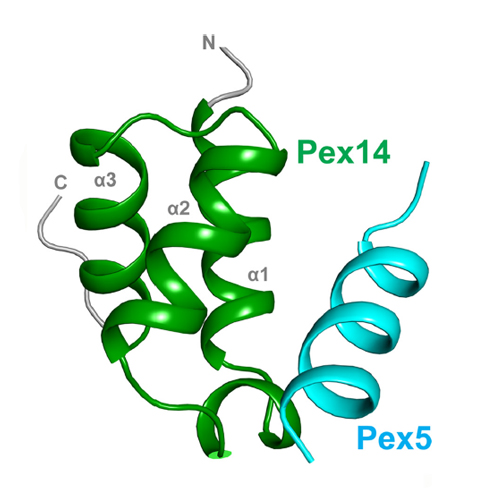A Novel Pex14 Protein-interacting Site of Human Pex5 Is Critical for Matrix Protein Import into Peroxisomes
14-Nov-2013
The Journal of Biological Chemistry, 2013, doi: 10.1074/jbc.M113.499707, 289, 437-448. published on 14.11.2013
The Journal of Biological Chemistry, online article
The Journal of Biological Chemistry, online article
Protein import into peroxisomes relies on the import receptor Pex5, which recognizes proteins with a peroxisomal targeting signal 1 (PTS1) in the cytosol and directs them to a docking complex at the peroxisomal membrane. Receptor-cargo docking occurs at the membrane-associated protein Pex14. In human cells, this interaction is mediated by seven conserved diaromatic penta-peptide motifs (WXXX(F/Y) motifs) in the N-terminal half of Pex5 and the N-terminal domain of Pex14. A systematic screening of a Pex5 peptide library by ligand blot analysis revealed a novel Pex5-Pex14 interaction site of Pex5. The novel motif composes the sequence LVAEF with the evolutionarily conserved consensus sequence LVXEF. Replacement of the amino acid LVAEF sequence by alanines strongly affects matrix protein import into peroxisomes in vivo. The NMR structure of a complex of Pex5-(57–71) with the Pex14-N-terminal domain showed that the novel motif binds in a similar α-helical orientation as the WXXX(F/Y) motif but that the tryptophan pocket is now occupied by a leucine residue. Surface plasmon resonance analyses revealed 33 times faster dissociation rates for the LVXEF ligand when compared with a WXXX(F/Y) motif. Surprisingly, substitution of the novel motif with the higher affinity WXXX(F/Y) motif impairs protein import into peroxisomes. These data indicate that the distinct kinetic properties of the novel Pex14-binding site in Pex5 are important for processing of the peroxisomal targeting signal 1 receptor at the peroxisomal membrane. The novel Pex14-binding site may represent the initial tethering site of Pex5 from which the cargo-loaded receptor is further processed in a sequential manner.











